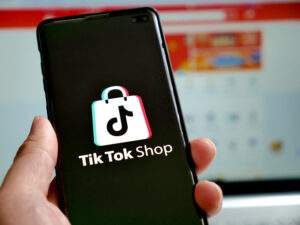Selling Has Gone Social
Published on October 29, 2025, at 1:27 p.m.
by Addie Nails
Once upon a time, a knock at the door meant a salesperson on your porch with samples, a smile and a practiced pitch. Now, that knock comes through your phone—in the form of a TikTok video or an Amazon link.
The era of door-to-door selling hasn’t vanished; it’s just gone digital and almost impossible to escape.

Social media has become the new neighborhood, and influencers are its most persuasive residents. With TikTok Shop, Like to Know It (LTK), Amazon Storefronts, and captions like “DM me for more details”, creators promote products directly from their posts—trading doorbells for clicks, views and commissions.
These platforms have turned content creation into a modern form of salesmanship. The strategy is simple—create content that feels personal and relatable with products that followers just have to have. A “get ready with me” video might casually feature a linked makeup product. A morning routine could spotlight a blender, health supplements or a new outfit, all available for purchase through affiliate links.
But not every product delivers on its promise. Weight loss supplements marketed as “life-changing,” skincare products promising “instant results,” and inexpensive clothing hauls claiming high-end quality often leave consumers disappointed. Despite consumer dissatisfaction, I see the same products consistently popping up in my feed by influencers who are more interested in turning a profit than giving an honest product review.
What’s more concerning is how easily these digital pitches blur the line between authenticity and advertising. The same influencers who share personal milestones or daily routines also sell products in the same breath.
The result? A feed that feels like a disguised marketplace where your favorite creators are profiting off you and your parasocial relationships they’ve built.

According to Shopify, influencer marketing has grown into a $21 billion industry in 2025. Many full-time creators earn six or even seven figures each year through brand partnerships and product sales. On TikTok Shop alone, top influencers can make thousands of dollars a week by promoting items through live streams or short-form videos.
Some creators participating in Amazon’s Influencer Program earn up to 10% commission per sale. Through LTK, influencers can share shoppable links and receive payouts every time followers make a purchase. For many, this has become a full-time career. A career that uses you as a consumer to be a source of their income.
What’s changed isn’t the pitch, but the platform. Instead of knocking on ten doors, influencers can reach millions of potential buyers in seconds. Their ability to build trust and connections with audiences is what fuels this industry of influencer marketing.
The sound of opportunity has changed from a doorbell to a ping, but the principle remains the same: people buy from people. In 2025, the most persuasive sales pitch doesn’t happen on your doorstep—it happens in your feed.




